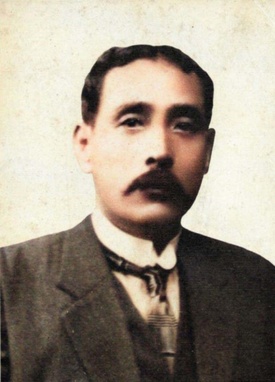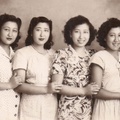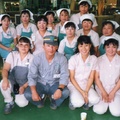How true is the saying that “Life takes many turns.”
However, sometimes, it is not that we return to the same place or time, but to a situation in the past very similar to the one from which we recognize the previous one. As in a spiral staircase, returning to the same point, but on a different plane.
In my particular case, and that of my grandfather on my maternal side—Rokuro Tojo (or “Todio”, as he was registered when entering Peru as an immigrant)—it happened that, due to life circumstances, we had to cross the Pacific Ocean in search for family well-being, repeating the same situations and motivations, 80 years later.
When analyzing the circumstances that my grandfather experienced to undertake the journey to Peru, I found many similarities with those that made me do the same.
Although it is true, I was not able to meet him, since he died before I was born, through his daughters (my mother and my three aunts), we listened to his story behind closed doors, as if it were something shameful, well, as You will see later, he served prison; A fact that the daughters kept secret for many years, until in 1991 the Medical College of Peru granted him a “Posthumous Recognition”, along with four other prominent Japanese doctors who made their valuable contribution to Peruvian medicine.
In these notes I want to share the story of my family's pioneer, Rokuro Tojo – “Doctor Todio” – in first person, based on the testimonies, notes, family photographs, newspaper clippings and research that I have been able to carry out.
* * * * *
Doctor Tojo, the pioneer
My name is Rokuro Tojo (Todio). I was born in 1882, in a small city called Kitakata, in Fukushima prefecture, where poverty was extreme and unemployment forced the youngest to abandon the fields because there was no money to buy seeds to plant.
Even in such a difficult situation, my parents always made an effort to offer me the best education and I managed to finish my upper secondary education ( kōkō ), and then pursue studies in obstetrics and pharmacy, which would be decisive in my life.
At the end of my studies I worked as an intern with several pharmaceutical doctors. However, it was not enough to support a family. Immigrating to other countries, something that was becoming popular among young people in the Japanese provinces, ended up being the alternative.
Opportunity and decision
One day, a close friend came with the news that he had signed up to travel to South American countries and told me about the experiences of other boys who had traveled and who, in a short period of work, were sending money to their relatives.
But what excited me was that the agency that hired him told him that, since many families with small children were traveling, they were looking for medical professionals to care for the immigrants hired by the estates. After much thought, and with the approval of my parents, I signed up to travel to Peru and practice my profession as an obstetrician and pharmacist.
The match
Year 1910, May 11. We are in the port of Yokohama aboard the Buyo Maru 1 , the ship that will take us to Peru. At the port there are family and friends who came to say goodbye to me, waving their hands and shouting at me “ ganbatte (try hard)” and “ genkide (take care…)”. With a lump in my throat and letting some tears flow, I said goodbye shouting to them that I will be back very soon.
Crossing the immense Pacific Ocean, every day we are further away from Japan and closer to Peru. From that moment on, doubts and fears arose. “I embarked on a dream for the sake of my family and I cannot let them down; Therefore, I will do my best to achieve the desired success and return to my loved ones soon,” I thought.
Arrival to “The Promised Land”
After a 49-day journey, on June 28, 1910 we arrived at the port of Callao. After so many days at sea, we couldn't wait to get back to dry land; However, the trip was not yet over and the ship had to continue its itinerary, leaving the families and young people hired by the estates from port to port, according to the places to which they were assigned.
And so the days went by, saying goodbye to traveling friends until it was our turn. A group of 12 people disembarked at the port of Cerro Azul, and then were transferred by cart to the Santa Bárbara hacienda in San Luis de Cañete.
When we arrived at the sugar plantation, we were installed in small huts made with materials very different from those found in homes in Japan: adobe walls, a roof made of wood and cane. In each accommodation we were placed in groups of six, and in the case of families, two per house.
In my case, because I had a different contract than my traveling companions, I got a house very close to the grocery store that consisted of two rooms: the one at the back would be my accommodation and the one at the front would function as an office-pharmacy.
Very early the next day, the hacienda staff began to distribute the newcomers into groups, according to each one's experience. Some went to till the land, others to sow and harvest, or to the processing and storage plant.
For my part, I unpacked my medical books and some basic instruments, and then prepared the premises for the care of the parturients. I also ordered additional materials for the office, which would take about two weeks to arrive from Lima, and I began to tour the farm visiting the families in order to introduce myself and learn about their state of health.
After a few weeks of attention, word had already spread among the local laborers about the medical post that had already come into operation, staffed by a Japanese doctor. And little by little they arrived to treat everything from simple colds to other injuries. Many of those who came were Peruvian workers on the hacienda, so I had to resort many times to the help of Mr. Maeda, who ran the grocery store, to serve as a translator.
Due to the need to communicate with patients, I had to learn Spanish, and in a short time I could communicate with the basics. Now they also came from other neighboring farms and, although the treatment for many of their illnesses was not my specialty, my knowledge of preparing medicines was very useful.
As far as my specialty is concerned, there were many Japanese families on the ranch who arrived three or four years before me. Some of the wives were waiting for a child, without any specialized attention, other than the experience of their neighbors.
My job was to assist them during childbirth and also ensure the health of the newborn. Many times I had to attend to the wives of Japanese workers from other nearby estates such as the Casa Blanca, La Quebrada, Unanue, etc., having to travel on horseback and on trips that took several hours.
Note:
1. Buyo Maru : Source of information, “Pioneers. Database of Japanese immigrants in Peru. 1899 - 1941.”
© 2023 Takahashi Takashi






